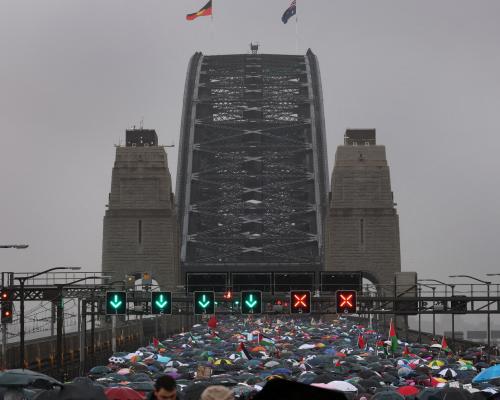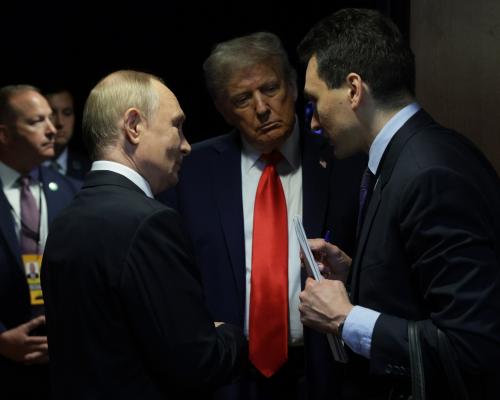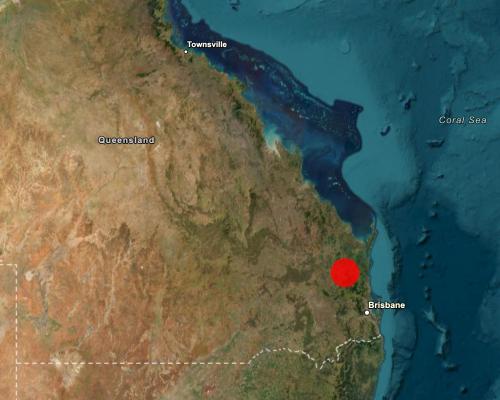
The number of people who joined a pro-Palestine march across Sydney Harbour Bridge on Sunday exceeded everyone’s expectations.
But just how many braved the rainy weather to urge the Australian government to do more to pressure Israel to stop the death and destruction in Gaza? That’s been a sticking point.
New South Wales police said initial estimates put the crowd at 90,000. A spokesperson for rally organisers the Palestine Action Group said police had informed them 100,000 people were in attendance – but the group estimated the figure was closer to 300,000.
Here’s what we know.
What do police and protesters say about how many people attended?
Just after 5pm on Sunday, the acting deputy police commissioner Peter McKenna said police estimated 90,000 people took part – far more than the 50,000 organisers expected.
He said it was the largest protest he and the assistant police commissioner Adam Johnson had seen in their time in the force. Johnson also said it was the “most perilous” in his “35 years of policing”.
However organisers estimated it was closer to 300,000.
“It’s even bigger than my wildest dreams,” one of the main protest organisers, Josh Lees, said while at the front of the march at the midway point.
Lees later said a number of people had come up with a similar figure after crunching the numbers based on widely shared aerial footage.
What about an independent expert?
Dr Aldo Raineri, a senior CQUniversity lecturer and expert in crowd safety management, estimated the figure to be significantly higher than what police suggested.
Guardian Australia shared drone footage with Raineri that showed the crowd just north of the bridge’s midway point, extending back to Wynyard station and Lang Park, where the march began.
Sign up: AU Breaking News email
The distance from Wynyard station up to where protesters began to be turned back is approximately 2.5km. The roadway along the bridge is 30 metres wide.
Based on these dimensions and what appeared to be an occupancy of three or four people per square metre, he estimated between 225,000 and 300,000 people attended.
However, he noted “these figures are really rough, given the variation in density”.
Organisers said there were still people at Lang Park, who had not yet started to march, when police sent a message telling protesters to turn back.
How does Sunday’s march compare with past marches?
Lees said many who had gone to Sunday’s protest felt it was on par with past major protests they had been to, including the anti-Iraq war protest in 2003, which saw demonstrators march through the CBD, and the walk for reconciliation march in 2000 which went across the Sydney Harbour Bridge.
According to the National Museum of Australia, about 250,000 people walked across the bridge in a continuous stream lasting nearly six hours during the reconciliation march. NMA called it the “largest political demonstration ever held in Australia”.
In 2003, police estimated more than 200,000 took part in the anti-Iraq war rally, while organisers put the total at about 300,000, the Sydney Morning Herald reported. The paper said it was “thought to be the biggest in the country’s history”.
In 2023, an estimated 50,000 people took part in a march across the Sydney Harbour Bridge as part of WorldPride.

Chris Nash, who attended Sunday’s march, said it “felt much bigger” than the 2000 reconciliation march he also attended.
“That was much more spaced out,” he said.
The former NSW premier Bob Carr marched at the head of the pro-Palestine protest across the bridge. He was the premier during the reconciliation march in 2000.
Asked how the crowd sizes compared, he said: “All that matters was that it was a big, beautiful success. A success with cheerful police cooperation and good-natured people motivated by the horror of Israel’s actions in Gaza.”
How well did police handle huge number of protesters?
At about 3pm on Sunday, NSW police sent out a mass text message throughout the city ordering the pro-Palestine march to stop due to safety concerns, with authorities turning protesters around at the north end of the bridge.
Police sent a second mass text message saying they had consulted with the organisers and were turning everyone around.
“We could not get those people, the number, the significant size of that crowd off that northern egress route without risking crowd crush. We could not allow those numbers to then egress into the northern side, into those train stations without, again, that real risk of crowd crush,” McKenna told reporters. He said there were 1,000 police facilitating the protest.
Raineri said allowing the crowd to amass without effective transport to disperse them would have been unsafe. He said the police went about this the right way by using mass text messages and consultating with protesters.
However, Legal Observers NSW said the “confusing and unplanned” directions from police were dangerous and could have caused a crowd crush.
“Police had not adequately planned for the initial route to North Sydney and there did not appear to be a plan if crowd numbers exceeded expectations and made entering and leaving North Sydney difficult,” the group’s report on the protest said.





